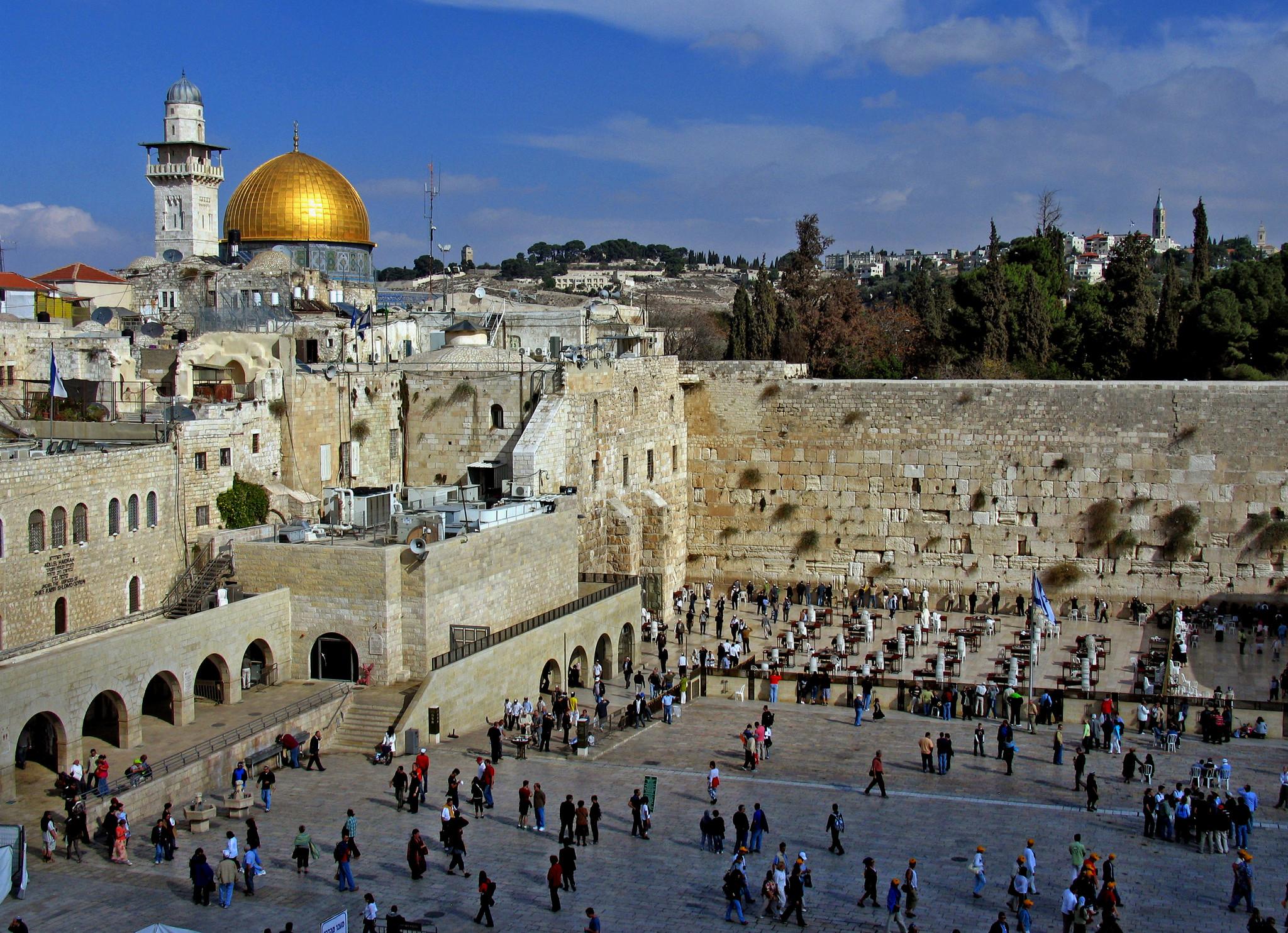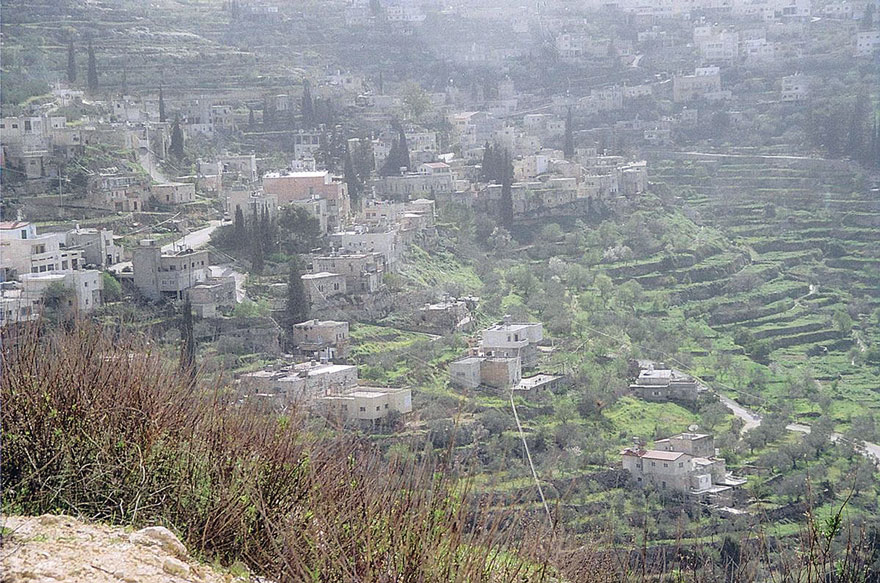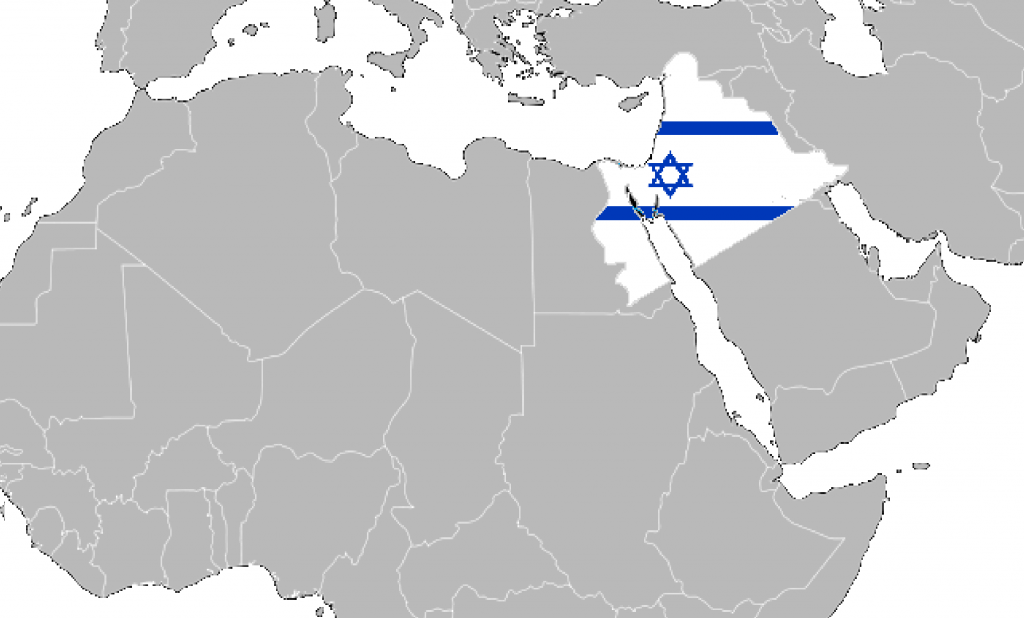
Views: 3031
Israel will soon bar all access to a Palestinian village whose farmers have continued a tradition stretching back thousands of years of tending stone terraces to grow crops in the fertile uplands outside Jerusalem.
These farmers are among the latest victims of Israeli efforts to put in place the final pieces of a Greater Jewish Jerusalem that will require “ethnically cleansing” tens of thousands of Palestinians from a city their families have lived and worked in for generations, human rights groups have warned.
The villagers of Walaja, many of them holding Israeli papers as “residents” of Jerusalem, were warned in November that they will be penned behind a military checkpoint and Israel’s concrete and steel “separation barrier.” The terraces they have farmed for generations and a historic spring where they water their livestock will be off-limits, becoming instead attractions for Israelis in an expanded Jerusalem metropolitan park.
 A brochure issued by the Israel Nature and Parks Authority describes the terraces as an “outstanding feature” that has “decorated the Judean Hills for longer than 5,000 years, since man started farming the land.” In an effort to deny Walaja’s current ties to the land, the brochure adds that “terrace agriculture was preserved in the Arab [Palestinian] villages until the [1948] War of Independence.”
A brochure issued by the Israel Nature and Parks Authority describes the terraces as an “outstanding feature” that has “decorated the Judean Hills for longer than 5,000 years, since man started farming the land.” In an effort to deny Walaja’s current ties to the land, the brochure adds that “terrace agriculture was preserved in the Arab [Palestinian] villages until the [1948] War of Independence.”
The pace of physical and demographic changes in and around Jerusalem has accelerated dramatically since Israel began building a steel and concrete barrier through the city’s Palestinian neighborhoods more than a decade ago, according to the rights groups and Palestinian researchers.
Israel is preparing to cement these changes in law, they note. Two parliamentary bills with widespread backing among government ministers indicate the intended contours of Jerusalem’s future.
One bill calls for the annexation to Jerusalem of some 150,000 Jews in illegal West Bank settlements surrounding the city. As well as bolstering the city’s Jewish population, the move will give these additional settlers a vote in Jerusalem’s municipal elections, pushing it politically even further to the right.
Another bill will deny more than 100,000 Palestinians—on the “wrong” side of the barrier—rights in the city. They will be assigned to a separate local council for Palestinians only, in what observers fear will be a prelude to stripping them of residency and barring them from Jerusalem.
The scheme, say planning experts, offers a double benefit to the far-right government of Binyamin Netanyahu. It decisively reverses the strong demographic growth of the city’s Palestinians, helping to engineer a strong Jewish majority to “Judaize” Jerusalem. And it also allows Israel to covertly annex the large West Bank settlement blocs near Jerusalem.
Meanwhile, a web of harsh Israeli policies, including late-night arrests, land shortages, home demolitions and a denial of basic services, are intensifying the pressure on Palestinians living inside the wall to move out.
These measures are designed to pre-empt any future peace efforts, and effectively nullify Palestinian ambitions for a state with East Jerusalem as its capital, said Aviv Tatarsky, a field researcher with Ir Amim, an Israeli group advocating fair treatment for Palestinians in Jerusalem.
“What is going on is ethnic cleansing, without guns,” Tatarsky said. “Israel hopes to get rid of a third of Jerusalem’s Palestinian population through legislative moves alone.”
Israel’s refashioning of Jerusalem borders has hit Walaja hard because it sits half-in and half-out of the muncipality’s area of jurisdiction. The villagers have found themselves caught in the worst of both worlds.
Jerusalem authorities have issued dozens of home demolition orders, many of them over the past year, as it strictly enforces its planning regulations on the “Jerusalem side” of Walaja, where some 100 families live. There was a large stand-off between residents and municipal demolition crews in August.
The villagers say Israel is seeking to drive them out of the village by criminalizing their homes.
But at the same time, all of Walaja’s houses have been sealed off from Jerusalem by the final sections of the separation barrier wending its way through the city. Israel is also preparing to move a military checkpoint some 2 kilometers closer to Walaja to cut residents off from the agricultural terraces the villagers have cultivated for generations.
Following these changes, the village’s historic terraces will be treated as inside Jerusalem’s borders, while Walaja’s residents will effectively have been ejected outside the city limits.
Walaja’s plight has been replicated for tens of thousands of Palestinians across East Jerusalem who are being gradually cut adrift from the city.
Israel’s demographic concerns in Jerusalem date back to 1967, when it occupied and annexed East Jerusalem, combining the large Palestinian population there with West Jerusalem’s Jewish population. It also expanded the city’s municipal borders as a way to covertly annex West Bank land.
Israel initially set an upper limit ratio of 30 percent Palestinians to 70 percent Jews in what it called its new “united, eternal capital,” but has been losing the battle to maintain that ratio ever since. Higher Palestinian birth rates mean that today there are more than 315,000 Palestinians in East Jerusalem, comprising nearly 40 percent of the city’s total population. Projections suggest Palestinians could be a majority within a decade.
Although few Palestinians in Jerusalem have taken or been allowed Israeli citizenship, and almost none vote in municipal elections, Israel fears their growing numerical weight will increasingly make its rule in the city untenable.
“What we have in Jerusalem is an apartheid system in the making,” Mahdi Abdul Hadi, a Palestinian academic in Jerusalem, said. “Israeli policies are dictated by demographic considerations, and that has created a huge gulf between the two societies. Palestinians are being choked.”
Fear of the demographic loss of Jerusalem provoked the launch of a high-profile campaign by political and security leaders last year: “Save Jewish Jerusalem.” Fearful that Palestinians will soon be a majority and might start voting in municipal elections, the campaign warned Jewish residents that soon they would “wake up to a Palestinian mayor in Jerusalem.”
Over the past year government ministers, including Education Minister Naftali Bennett, have aggressively pushed for the annexation of Ma’ale Adumim, a large settlement outside Jerusalem, in the West Bank. Gradually, they appear to be winning the argument.
In late October a ministerial committee was set to approve a Greater Jerusalem Bill, legislation intended to expand Jerusalem’s municipal borders to include Ma’ale Adumim and several other large settlements in the West Bank. It won Netanyahu’s backing.
The settlements would have been annexed in all but name, and their 150,000 residents become eligible to vote in Jerusalem municipal elections.
Yisrael Katz, the minister of transport and intelligence who helped introduce the bill, has said its purpose is to “safeguard a Jewish majority” in the city. A recent poll showed 58 percent of Israeli Jews support the plan.
Under pressure from the administration of President Donald Trump, Netanyahu has temporarily put the bill on the back burner. Washington is reportedly worried that the legislation will stymie a peace initiative it is reportedly about to unveil.
Ir Amim fears the legislation is likely to be revived when pressure dissipates. A position paper it published in November warned that the legislation was the “first practical move since the annexation of East Jerusalem in 1967 to implement the de facto annexation of areas in the West Bank to Israel.”
After decades of implanting Jewish settlers in the midst of Palestinian areas to prevent the latter’s development and growth, Israel is beginning the difficult process of disentangling the two populations, said Tatarsky.
The effects are being felt keenly on the ground—and not just in Walaja.
In November, Israeli forces stormed the Bedouin village of Jabal al-Baba and issued “eviction” notices to its 300 residents. In August the Israeli army demolished the village’s kindergarten school.
Jabal al-Baba stands between East Jerusalem and Ma’ale Adumim.
“These Palestinian communities outside Jerusalem are like a bone in the throat for Israel,” said Tatarsky. “Israel is trying to make their life as hard as possible to force them to leave, and so create a territorial continuity between Jerusalem and the settlements.”
Meanwhile, Israel is tightening its chokehold on Palestinians in East Jerusalem’s built-up areas.
Those on the far side of the concrete wall have been effectively abandoned by the Jerusalem municipality, and are finding it ever harder to access the rest of the city, said Daoud Alg’ol, a Palestinian researcher on Jerusalem.
A bill by Ze’ev Elkin, the Jerusalem affairs minister, is designed to disconnect from the Jerusalem municipality Palestinian neighbouhoods such as Walaja, Kafr Aqab, Shuafat refugee camp and Anata, which lie beyond the separation wall.
They would be shunted off into a separate local council for Palestinians, instantly reducing the city’s Palestinian population by a third.
“Once Palestinians are in a separate local council, Israel will say the center of their life is no longer in Jerusalem and their Jerusalem residency papers will be revoked,” said Alg’ol. “This already happens, but now it will be on a much larger scale.”
Since 1967, Israel has revoked the residency permits of more than 14,000 Palestinians, forcing them to leave Jerusalem.
Even though their residents pay taxes to the Jerusalem municipality, Palestinian areas outside the barrier are already “twilight zones” of neglect and lawlessness.
In Kafr Aqab, for example, which is sealed off from the rest of East Jerusalem behind the wall and a military checkpoint, residents receive few services. Israel, however, has also denied the Palestinian Authority access.
“They are living in a no-man’s land,” said Alg’ol.
These areas have become a destination both for criminals and for Palestinian families caught out by Israel’s intricate web of strict residency regulations. Palestinians in the West Bank are denied access inside Jerusalem’s wall, while Palestinians in Jerusalem risk being stripped of their residency papers if they move out of the city.
Couples who have married across that residency divide have found a refuge in Kafr Aqab as Israel slowly disconnects the neighborhood from East Jerusalem. Residents say the population there has rocketed from a few thousand to tens of thousands in the past few years.
As a result, a building boom has taken place beyond the wall as Palestinians take advantage of a lack of enforcement by Israel of its building regulations. That has offered demographic gains for Israel too, said Alg’ol.
A Silent Transfer
“Planning restrictions and land shortages inside the wall have created a housing crisis for Palestinians, making it too expensive for them to live there,” he said. “They have been forced to move to areas outside the wall to find more affordable housing. Economic pressure is creating a silent transfer.”
Palestinians in neighborhoods inside the wall are being driven out in other ways, noted Tatarsky.
Traditionally, Israel has used a range of policies to strip Palestinians of land and prevent development in Jerusalem and justify home demolitions.
Those have included declaring Palestinian areas “national parks,” thereby criminalizing the homes in them; confiscating the last green areas to build Jewish settlements; and allowing settlers to take over Palestinian properties in Jerusalem’s Old City and surrounding neighborhoods as Israel seeks to strengthen its hold over
the city’s holy sites, especially al-Aqsa mosque.
There are now some 200,000 Jewish settlers living in East Jerusalem.
“Palestinians are never part of the planning in Jerusalem, and their interests are never taken into account—they are always an obstacle to be removed,” Alg’ol said. “Israel wants the land but not the Palestinians on it.”
Pressure has mounted on Palestinians in Jerusalem, noted Tatarsky, as their communities have been denied schools and basic municipal services. More than 80 percent of Palestinian children live below the poverty line.
Collective Punishment
The Jerusalem municipality and police have also begun stepping up “law enforcement” operations against Palestinians—or what residents term “collective punishment.” Under the pretense of “restoring order,” there has been a wave of recent late-night raids in areas like At-Tur and Issawiya. Large numbers of Palestinians have been arrested, demolition orders issued and businesses closed.
“Israel is using the same militarized methods as in the West Bank,” said Tatarsky. “The assumption is these pressures will encourage them to move to areas outside the barrier, where sooner or later they will lose their residency rights.
“Israel has realized that is an opportunity it can exploit,” he stated.
The office of Jerusalem’s mayor, Nir Barkat, issued a statement denying that the situation of Palestinians in East Jerusalem was deteriorating. It said that there had been dramatic improvements in Palestinian areas in the provision of schools, community centers, sports fields, new roads, postal services and welfare.
It added that
Barkat had “developed a plan unprecedented in scope and budget allocation to reduce gaps in East Jerusalem in order to address the 50 years of neglect he inherited from his municipal predecessors and successive Israeli governments.”
Alg’ol described the municipal claims as a denial of reality.
“Israel wants to create a make-believe city free of Palestinians,” he said. “Where it can, it is ethnically cleansing them from the city. And where it can’t, it simply hides them from view.”
Originally published on 2017-12-10
About the author: Jonathan Cook is a journalist based in Nazareth and a winner of the Martha Gellhorn Special Prize for Journalism. He is the author of Blood and Religion and Israel and the Clash of Civilisations (available from AET’s Middle East Books and More).
Source: WRMEA.org
Origins of images: Facebook, Twitter, Wikimedia, Wikipedia, Flickr, Google, Imageinjection, Public Domain & Pinterest.
Read our Disclaimer/Legal Statement!
Donate to Support Us
We would like to ask you to consider a small donation to help our team keep working. We accept no advertising and rely only on you, our readers, to keep us digging the truth on history, global politics and international relations.
FOLLOW US ON OUR SOCIAL PLATFORMS










